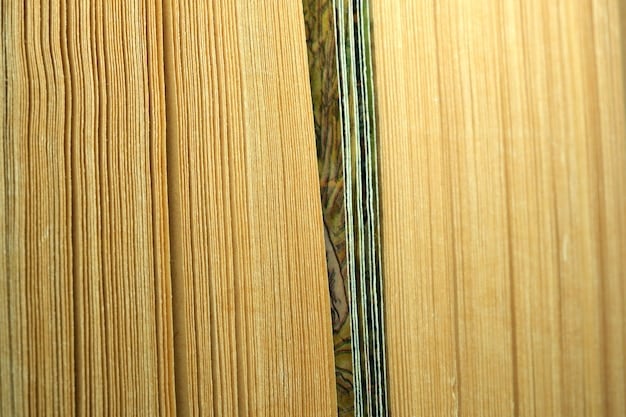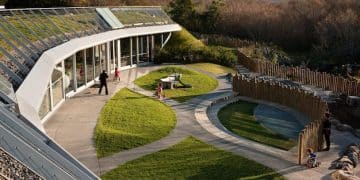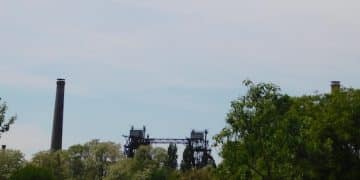Discover the Environmental Benefits of CLT in US Construction

Cross-laminated timber (CLT) offers significant environmental benefits in US construction projects, including carbon sequestration, reduced greenhouse gas emissions, and sustainable forest management, making it a viable alternative to traditional building materials like concrete and steel.
Discover the transformative impact of cross-laminated timber (CLT) on the US construction industry. This innovative material offers a pathway to greener building practices. What Are the Environmental Benefits of Using Cross-Laminated Timber (CLT) in US Construction Projects? From reducing carbon footprints to promoting sustainable forestry, explore how CLT is reshaping the future of construction.
Understanding Cross-Laminated Timber (CLT)
Cross-laminated timber (CLT) is an engineered wood product gaining traction in US construction. It’s made by layering kiln-dried lumber boards, glued together, to form solid, large-scale panels. This construction method offers a sustainable alternative to traditional materials.
CLT’s unique composition gives it exceptional strength and stability, making it suitable for various building applications. From walls and floors to roofs, CLT is transforming how we approach construction.
What is CLT, and How is it Made?
CLT is manufactured by stacking layers of lumber, each oriented perpendicularly to the adjacent layers. This cross-lamination provides dimensional stability and strength. The layers are then bonded together with structural adhesives.
Key Properties and Applications of CLT
CLT panels are known for their high strength-to-weight ratio. They offer excellent thermal and acoustic insulation. Applications include residential, commercial, and industrial buildings, as well as bridges and other infrastructure.
- CLT offers design flexibility and can be prefabricated.
- It provides a sustainable alternative to concrete and steel.
- CLT construction can reduce on-site construction time and labor costs.
In summary, CLT represents a versatile and eco-friendly building material. Its unique properties and diverse applications make it a compelling choice for sustainable construction in the US.
Carbon Sequestration: CLT as a Carbon Sink
One of the most significant environmental benefits of CLT is its ability to sequester carbon. Trees absorb carbon dioxide from the atmosphere as they grow. When timber is used in construction, this carbon remains stored within the wood.
CLT construction effectively turns buildings into long-term carbon storage facilities. This process helps mitigate climate change by reducing the amount of carbon dioxide in the atmosphere.

How CLT Stores Carbon Dioxide
As trees grow, they convert carbon dioxide into biomass through photosynthesis. When CLT is used in building construction, the carbon remains trapped within the wood fibers.
Comparing Carbon Footprints: CLT vs. Traditional Materials
Compared to concrete and steel, CLT has a significantly lower carbon footprint. The production of concrete and steel is energy-intensive and releases substantial amounts of carbon dioxide into the atmosphere. CLT, on the other hand, stores carbon and requires less energy to produce.
CLT’s capacity for carbon sequestration makes it an attractive material for environmentally conscious builders. It supports efforts to reduce greenhouse gas emissions and combat climate change.
Overall, CLT serves as an effective carbon sink in construction. It offers a sustainable approach to reducing the carbon footprint of buildings in the US.
Reducing Greenhouse Gas Emissions
Choosing CLT over traditional building materials can substantially reduce greenhouse gas emissions. The production of concrete and steel involves high-energy processes and significant emissions. CLT offers a cleaner alternative.
By reducing the reliance on carbon-intensive materials, CLT contributes to a more sustainable construction industry. This shift is vital for meeting climate goals and promoting environmental stewardship.
Lower Energy Consumption in Production
CLT production generally consumes less energy compared to concrete and steel. Wood requires less processing, and the manufacturing process emits fewer greenhouse gases.
Decreased Transportation Emissions
CLT can often be sourced locally, reducing transportation distances and associated emissions. This contrasts with materials like steel and concrete that may need to be transported long distances.

- CLT supports a circular economy approach by utilizing renewable resources.
- It minimizes waste through prefabricated construction techniques.
- Using CLT can contribute to LEED certification and other green building standards.
Reduced greenhouse gas emissions are a key environmental benefit of using CLT. It aligns with global efforts to mitigate climate change and promote sustainable development.
Sustainable Forest Management
The environmental benefits of CLT extend to forest management practices. Responsible forestry is essential to ensure a continuous supply of timber while maintaining ecosystem health.
Sustainable forest management focuses on balancing timber harvesting with conservation efforts. This approach supports biodiversity, protects watersheds, and ensures long-term forest productivity.
The Role of Responsible Forestry Certifications
Certifications like the Forest Stewardship Council (FSC) ensure that forests are managed sustainably. These certifications promote responsible harvesting practices that protect forest ecosystems.
Promoting Forest Health and Biodiversity
Sustainable forest management promotes forest health and biodiversity by maintaining diverse habitats. It minimizes the impact of timber harvesting on local ecosystems.
Sustainable forest management benefits include increased carbon sequestration and climate resilience. It supports local communities and economies that depend on forest resources.
In summary, sustainable forest management is integral to the environmental benefits of CLT. It ensures that timber resources are managed responsibly and that forests continue to provide ecological and economic benefits.
Reduced Construction Waste
CLT construction significantly reduces waste compared to traditional methods. Prefabrication and precise manufacturing minimize on-site cutting and material waste.
Reducing construction waste conserves resources, lowers disposal costs, and minimizes environmental impacts. It aligns with circular economy principles and supports sustainable development.
Prefabrication and Precision Manufacturing
CLT panels are prefabricated in factories to exact specifications. This precision reduces the need for on-site modifications and minimizes material waste.
Efficient Use of Resources
CLT production optimizes resource use by utilizing smaller pieces of lumber. This reduces reliance on large-diameter trees and maximizes the use of available timber resources.
Benefits of reduced construction waste include lower landfill volumes and decreased disposal costs. It promotes resource efficiency and contributes to a more sustainable construction industry.
Overall, reduced construction waste is a notable environmental advantage of using CLT. It supports sustainable building practices and promotes resource conservation.
Improved Building Performance
CLT offers enhanced building performance through improved insulation, energy efficiency, and resilience. These benefits contribute to reduced environmental impacts and lower operating costs.
Better building performance results in reduced energy consumption, lower carbon emissions, and improved occupant comfort. It supports sustainable development and promotes long-term value.
Thermal Insulation and Energy Efficiency
CLT provides excellent thermal insulation, reducing the need for heating and cooling. This leads to lower energy consumption and reduced carbon emissions.
Acoustic Performance
CLT offers good acoustic performance, reducing noise transmission and creating quieter indoor environments. This enhances occupant comfort and productivity.
- CLT buildings are more resilient to natural disasters.
- CLT provides better indoor air quality.
- CLT promotes sustainable building design and construction practices.
Enhanced building performance is a significant environmental benefit of using CLT. It contributes to energy efficiency, occupant comfort, and long-term sustainability.
| Key Benefit | Brief Description |
|---|---|
| 🌳 Carbon Sequestration | CLT stores CO2 absorbed by trees, reducing atmospheric carbon. |
| 🏭 Reduced Emissions | CLT production emits fewer greenhouse gases than concrete or steel. |
| ♻️ Waste Reduction | Prefabrication minimizes construction waste on-site. |
| 🌲 Sustainable Forestry | CLT supports responsible forest management for continuous timber supply. |
Frequently Asked Questions (FAQ)
▼
CLT is an engineered wood panel made by gluing layers of solid-sawn lumber together. Each layer is oriented perpendicular to adjacent layers for increased strength and stability. It provides a sustainable alternative to concrete and steel.
▼
CLT benefits the environment by sequestering carbon, reducing greenhouse gas emissions, and minimizing construction waste. It also supports sustainable forest management practices, ensuring a continuous supply of timber while protecting forest ecosystems.
▼
Yes, CLT is known for its high strength-to-weight ratio, making it a competitive alternative to concrete and steel in many construction applications. Modern CLT can meet or exceed building codes for strength and fire resistance.
▼
CLT can be sourced from sustainably managed forests, often certified by organizations like the Forest Stewardship Council (FSC). Sourcing CLT locally reduces transportation emissions and supports regional economies, promoting further eco-friendliness.
▼
CLT enhances building performance with improved thermal insulation, acoustic properties, and resilience to natural disasters. It contributes to energy efficiency, reducing heating and cooling costs, and provides better indoor air quality, enhancing occupant well-being.
Conclusion
In conclusion, the environmental benefits of using cross-laminated timber (CLT) in US construction projects are substantial and far-reaching. From carbon sequestration and reduced greenhouse gas emissions to sustainable forest management and improved building performance, CLT offers a compelling alternative to traditional building materials. As the construction industry continues to seek greener solutions, CLT stands out as a viable and eco-friendly option that can help create a more sustainable built environment.





